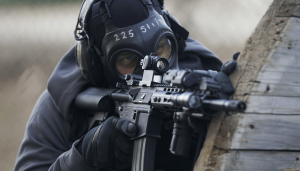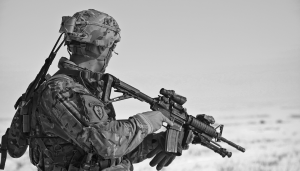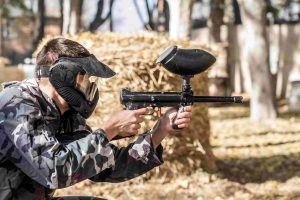Airguns have long been a favorite among hobbyists, hunters, and competitive shooters. Their affordability, accessibility, and reduced noise compared to traditional firearms make them an appealing option for many. However, while airguns may not have the same power as firearms, they are still capable of causing serious injury or even death if handled improperly. Whether you are a novice just starting or an experienced shooter refining your skills, following strict safety protocols is essential.
This guide covers the fundamental rules of airgun safety, the proper handling techniques, storage recommendations, and the legal responsibilities that every shooter should know.
Understanding the Risks of Airgun Use
One of the most common misconceptions about airguns is that they are completely harmless. While air rifles and pistols do not produce the same level of force as conventional firearms, they are powerful enough to cause significant harm.
- Pellet penetration: High-powered air rifles can fire pellets at speeds exceeding 1,000 feet per second (fps), which is fast enough to penetrate human skin and soft tissue.
- Eye injuries: One of the most frequent airgun-related injuries involves the eyes. Even low-velocity BB guns can cause permanent blindness.
- Accidental discharge: Mishandling or failing to check whether an airgun is loaded has resulted in countless avoidable accidents.
By treating every airgun as if it were a live firearm, you can significantly reduce the risk of injury.
The Golden Rules of Airgun Safety
Every shooter, regardless of experience level, must adhere to the core principles of firearm safety when handling an airgun. These rules are designed to minimize the likelihood of accidents and should be practiced at all times.
1. Always Treat the Airgun as if It’s Loaded
Even if you are confident that the chamber is empty, always assume that a round could be inside. Many accidents occur because shooters become complacent and fail to check their airgun before handling it.
2. Never Point the Airgun at Anything You Don’t Intend to Shoot
Muzzle control is one of the most important aspects of airgun safety. Keep the barrel pointed in a safe direction, preferably toward the ground or a designated target area. Never use an airgun to “joke around” or point it at another person.
3. Keep Your Finger Off the Trigger Until Ready to Fire
A common mistake among new shooters is resting their finger on the trigger before aiming. This increases the risk of an accidental discharge. Always keep your finger outside the trigger guard until you are ready to shoot.
4. Be Sure of Your Target and What’s Beyond It
BBs and pellets can ricochet off hard surfaces, potentially hitting unintended targets. When shooting outdoors, always check that there are no people, animals, or fragile objects beyond your intended target.
5. Always Wear Eye Protection
Shooting glasses or goggles are a must when handling an airgun. Pellets and BBs can ricochet unpredictably, and wearing protective eyewear can prevent severe eye injuries.
Safe Handling and Operation of Airguns
Understanding how to properly handle, load, and fire an airgun is crucial for safe shooting.
Loading and Unloading an Airgun
- Read the manufacturer’s manual carefully to understand your specific airgun model.
- Ensure that the safety is engaged before loading.
- Insert pellets or BBs correctly to prevent jamming.
- Always unload the airgun when finished shooting and store it safely.
Proper Shooting Stance and Grip
- Maintain a firm but relaxed grip on the airgun.
- Keep both feet planted in a stable stance, with your dominant foot slightly behind.
- Align your sights correctly before squeezing the trigger slowly and deliberately.
Safe Storage Practices for Airguns
Proper storage of an airgun is just as important as handling it safely. An unsecured airgun can pose a risk, especially in households with children.
- Use a gun safe or lockbox: If possible, store your airgun in a locked container to prevent unauthorized access.
- Store ammunition separately: Keeping pellets or BBs in a separate location reduces the risk of accidental use.
- Use trigger locks: A trigger lock adds an extra layer of security to prevent unintentional firing.
- Educate family members: Ensure that everyone in the household understands that airguns are not toys and should only be handled responsibly.
Shooting Safety in Different Environments
Indoor Shooting Safety
If you are shooting indoors, make sure you are in a designated space with a proper backstop. Use thick plywood, rubber mats, or commercial pellet traps to absorb the impact of shots. Avoid shooting in areas with windows, fragile objects, or hard surfaces that can cause ricochets.
Outdoor Shooting Safety
When shooting outside, always be aware of your surroundings.
- Avoid shooting in residential areas where stray pellets could cause damage.
- Ensure that you have permission to shoot on private property.
- Keep a safe distance from roads, sidewalks, and populated areas.
Legal Considerations for Airgun Owners
Airgun laws vary widely depending on your country, state, or local jurisdiction. Some regions have strict regulations regarding the purchase, ownership, and transportation of airguns.
- Minimum age requirements: Many areas have age restrictions for purchasing or using airguns.
- Power limitations: Some locations restrict the maximum velocity of airguns before they are classified as firearms.
- Carrying laws: Carrying an airgun in public, even if unloaded, may be illegal in certain jurisdictions.
Before purchasing an airgun, check with local authorities to ensure compliance with all regulations.
Conclusion
Safety is the foundation of responsible airgun ownership. By treating airguns with the same level of respect as traditional firearms, following safe handling practices, and securing them properly when not in use, you can enjoy shooting without unnecessary risks. Whether you’re a beginner learning the basics or an experienced shooter refining your skills, prioritizing safety will ensure that airgun sports remain an enjoyable and secure activity for everyone.



